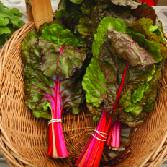-
CATEGORY ::
- All Seeds /
- All Cover Crop Seed











Trophy Rape Seed
About...
Trophy Rape - One of the most versatile of the brassicas, being suitable for a wide range of soil fertility, cover cropping and environmental conditions, stock classes and sowing times. Great for deer food plots too!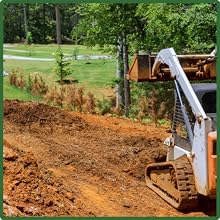
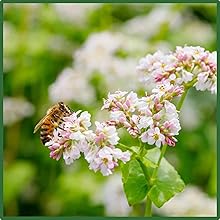
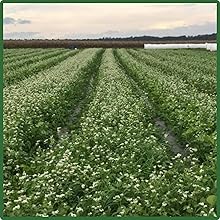
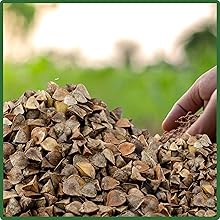
MORE COVER CROP OPTIONS
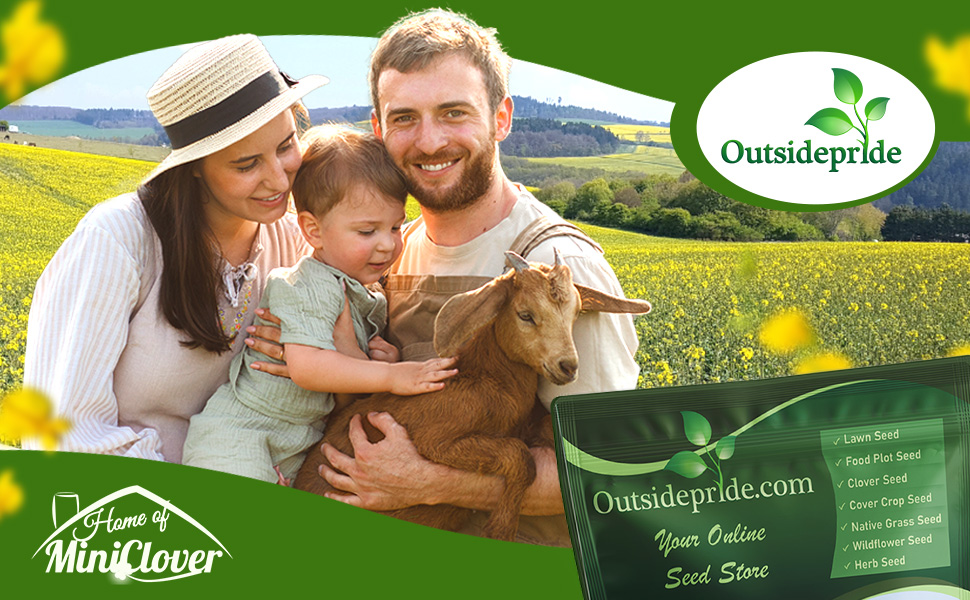
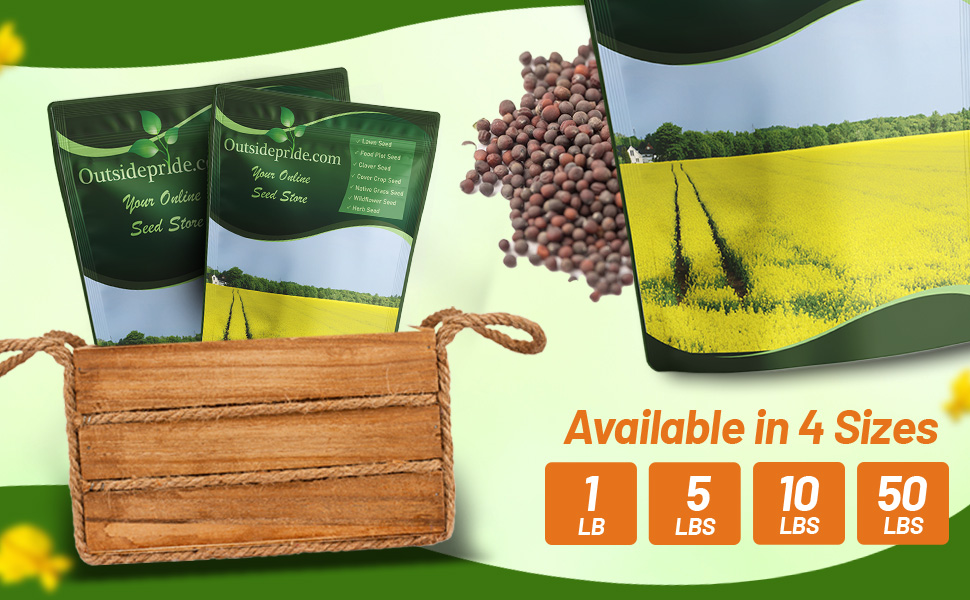

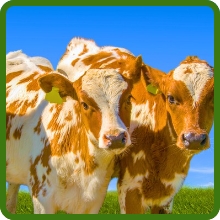
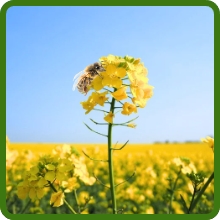
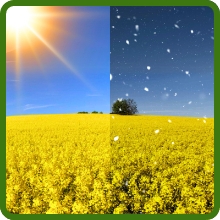
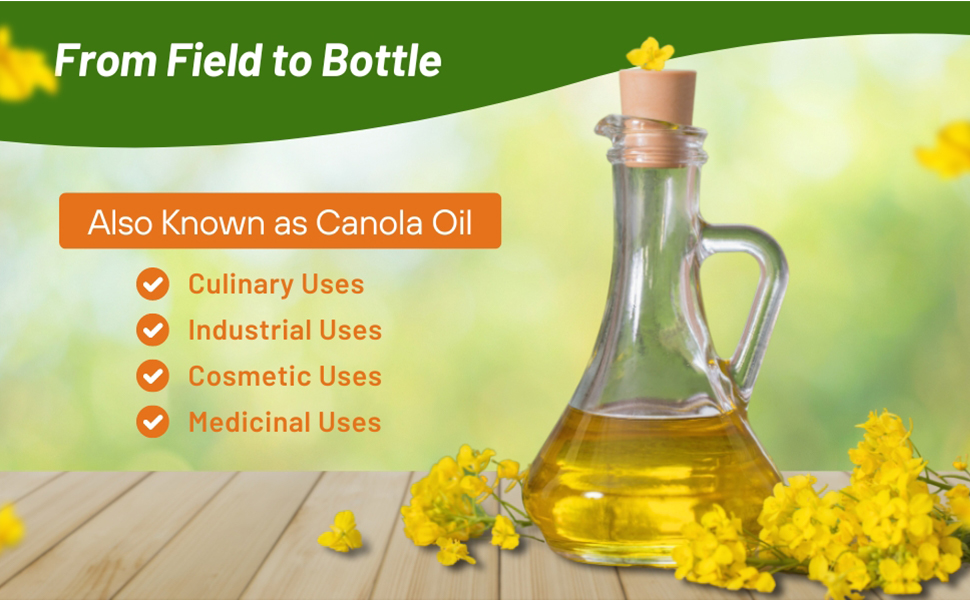
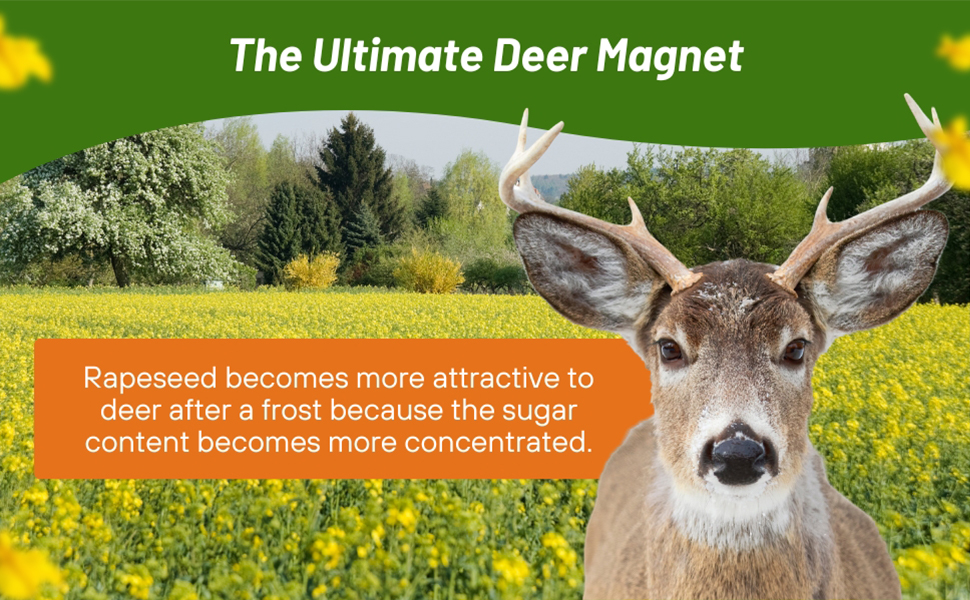
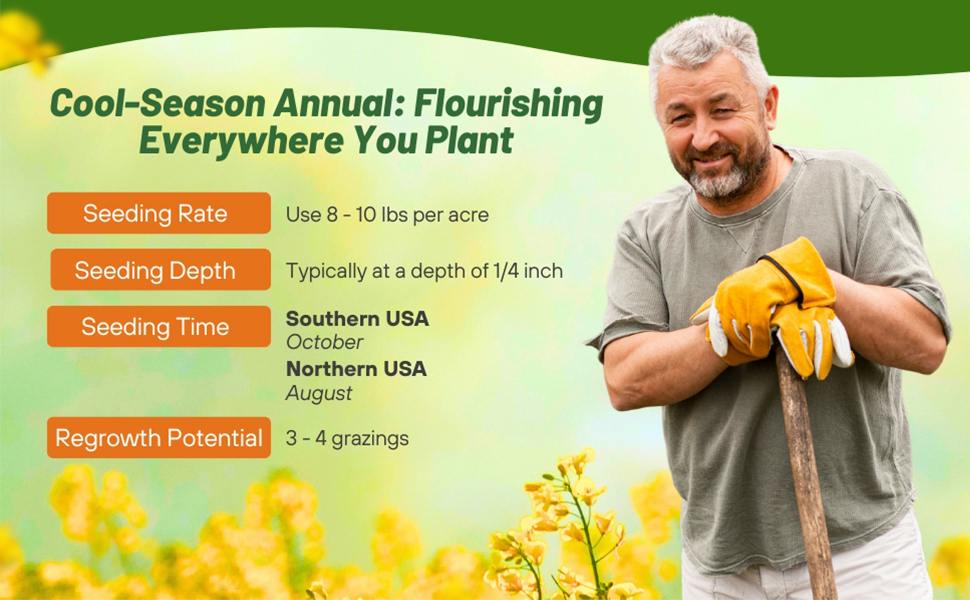
A forage brassica plant which is used extensively in deer food plots and for livestock grazing. Trophy rapeseed is a fast growing brassica that is heat, cold, and drought tolerant making it adapted to the USA. Rape becomes more attractive to deer after a frost because the sugar content will become more concentrated. Rape is a green leafy fast growing plant that produces large flat leafs that will grow between 12 to 20 inches long and 8 to 15 inches wide and may grow to a height of two to four feet. Forage produced can contain 18 - 20% crude protein. Good cold tolerance allows for harvesting or grazing late into the fall and winter.
Rapeseed also can be used effectively as a winter cover crop. Its deep tap roots are excellent at breaking soil compaction. The deep roots also help to scavenge after nutrients that are deep within the soil profile. The large amount of bio-mass that rape produces makes it a great green manure. Rape is becoming more and more widely used in cover crops and crop rotations because it establishes quickly, suppresses weed growth, and helps reduce soil erosion. Trophy is a canola type rape which produces large volumes of biomass with equal or higher feed values than alfalfa.Planting Guide
SOWING TEMPERATURE
60F - 70F
SEEDING RATE
8 - 10 lbs per acre
AVERAGE GERMINATION TIME
3 - 10 days
PLANTING DEPTH
1/4 inch
SOWING METHOD
Broadcast or drill
ENVIRONMENT
Full sun
USDA ZONES
5 - 9
ESTABLISHMENT RATE
Fast
Specifications:
LATIN NAME
Brassica napus
SEASON
Annual
WHEN TO PLANT
Late summer to early fall
IDEAL FOR
Deer food plots, grazing, pollinators, winter cover crop
PLANT CHARACTERISTICS
Fast growing, deer magnet, soil fertility
MOISTURE REQUIREMENTS
Moderate
CROP HEIGHT
20 inches
COLD TOLERANCE
Excellent
HEAT TOLERANCE
Moderate
SHADE TOLERANCE
Good
DAYS TO MATURITY
90 - 120 days
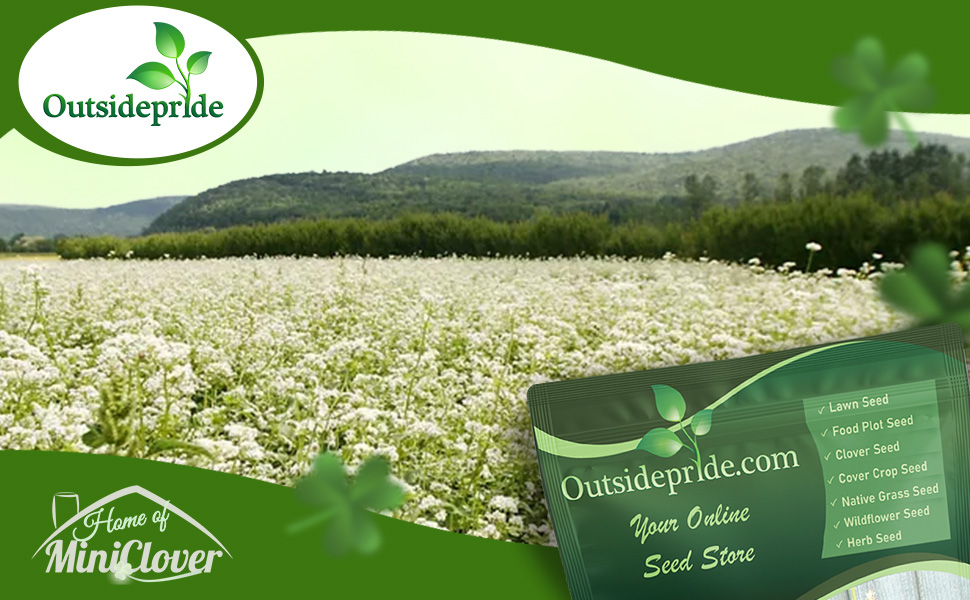
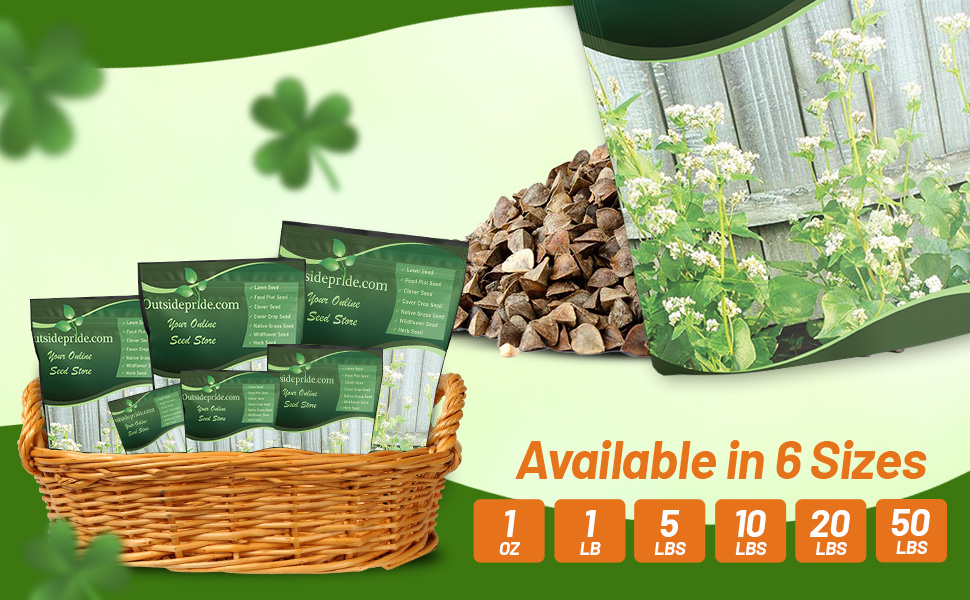
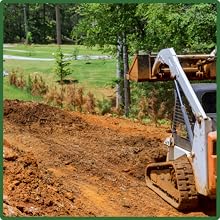
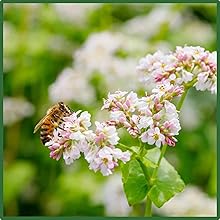
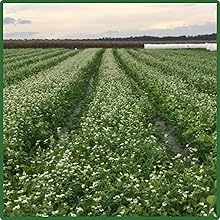
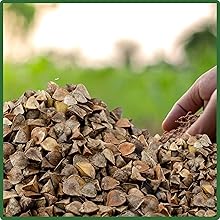
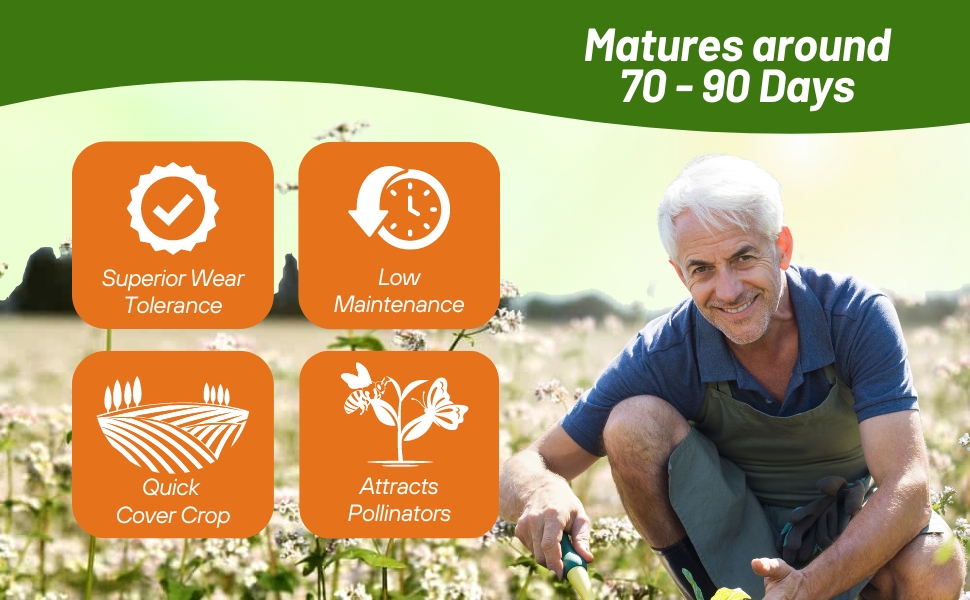
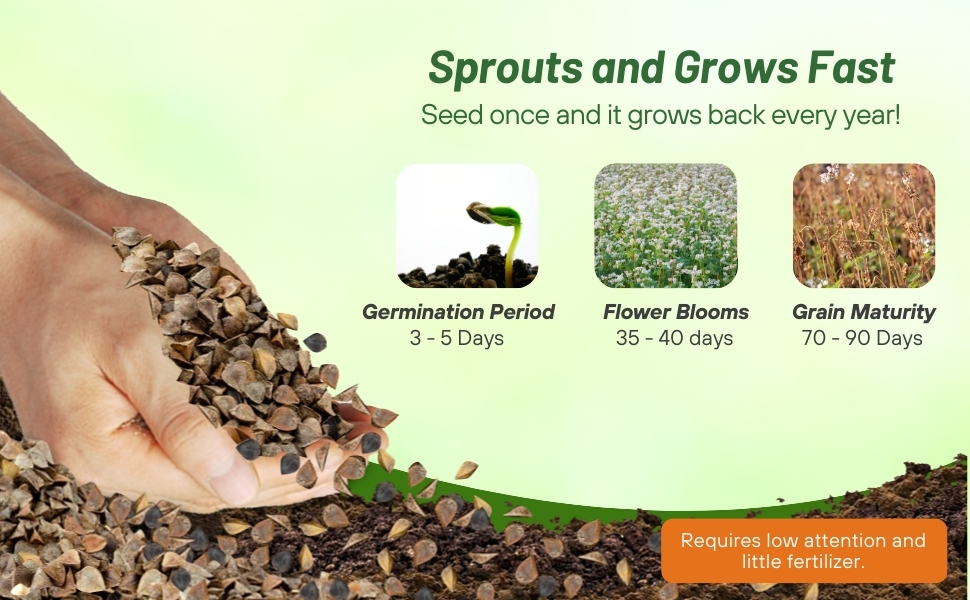
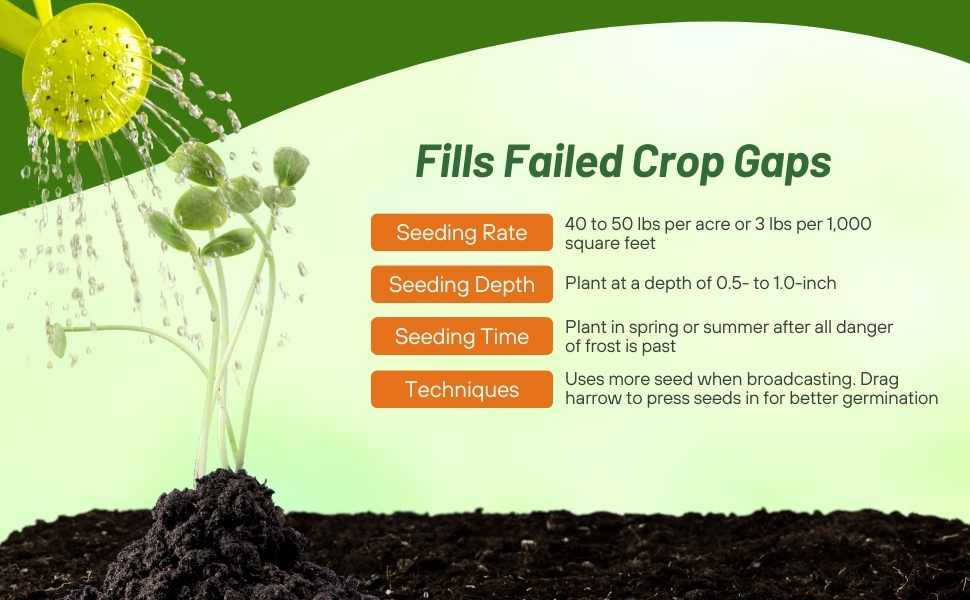
Reasons to grow buckwheat:
- Fits into rotations at a time when fields might otherwise be idle.
- Can be grown as a catch crop where another crop failed.
- Inexpensive to grow because it requires no pesticides and little fertilizer.
- Can be grown with equipment available on most farms.
- Requires little attention during the growing season.
- Mellows the soil and suppresses some weeds.
- Easily raised Organically, at a premium price.
For more information from Cornell University: Buckwheat
Planting Guide
SOWING TEMPERATURE
50F - 70F
SEEDING RATE
40 - 50 lbs per acre
AVERAGE GERMINATION TIME
3 - 5 days
PLANTING DEPTH
1/2 - 1 inch
SOWING METHOD
Broadcast or drill
ENVIRONMENT
Full sun
USDA ZONES
3 - 10
ESTABLISHMENT RATE
Fast
Specifications:
LATIN NAME
Fagopyrum esculentum
SEASON
Annual
WHEN TO PLANT
Late spring to mid summer
IDEAL FOR
Erosion control, nurse crop, companion crop, cover crop, food plot, pollinator
PLANT CHARACTERISTICS
Wear tolerant, fast growing, improves soil, nutritious grain
MOISTURE REQUIREMENTS
Moderate
CROP HEIGHT
36 - 48 inches
COLD TOLERANCE
Excellent
HEAT TOLERANCE
Good
SHADE TOLERANCE
Poor
DAYS TO MATURITY
70 - 90 days
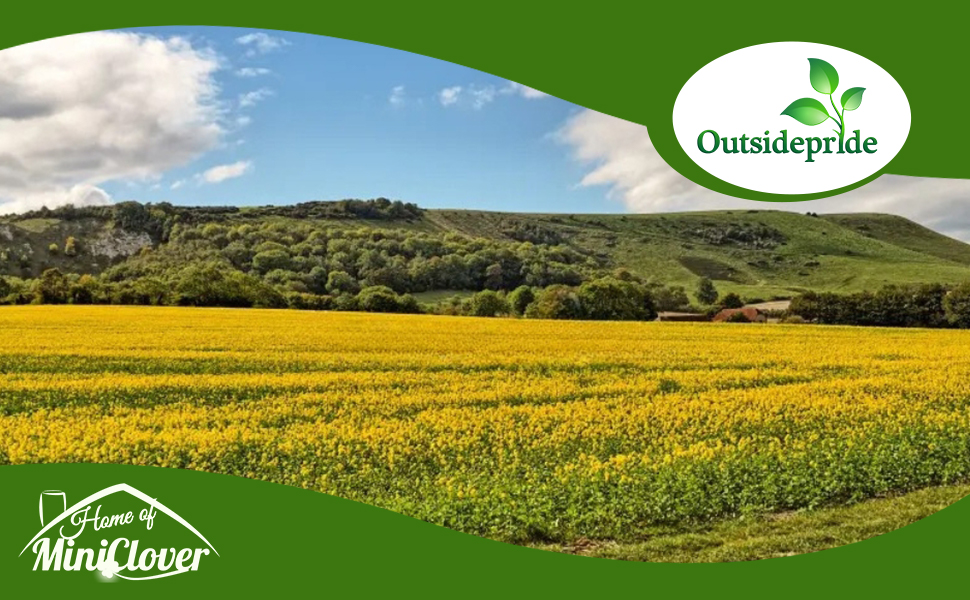
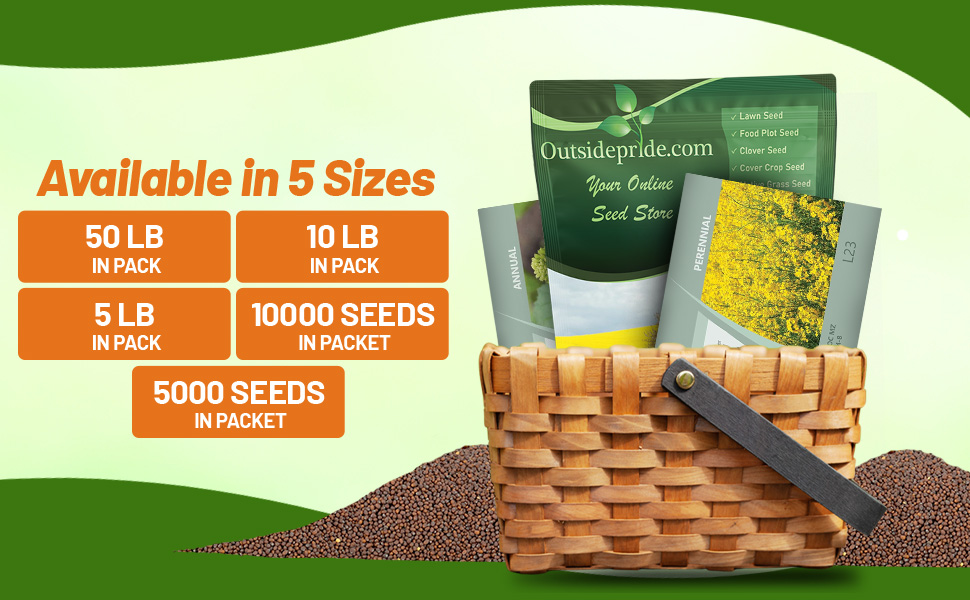
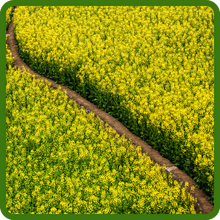
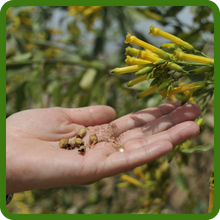
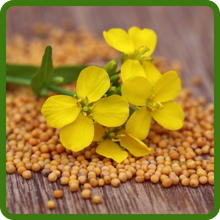
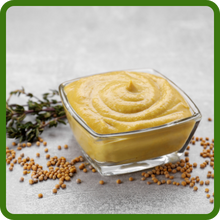
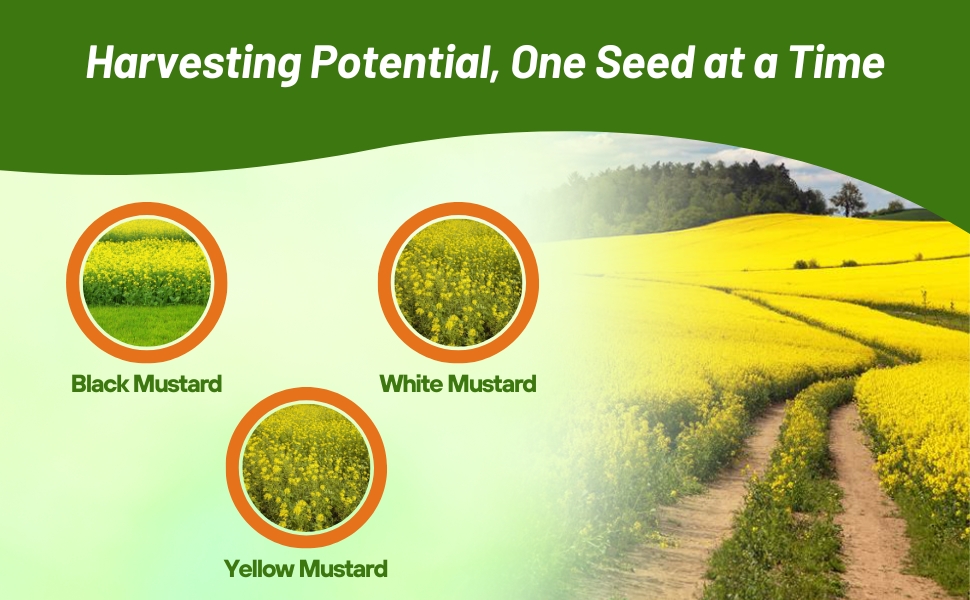
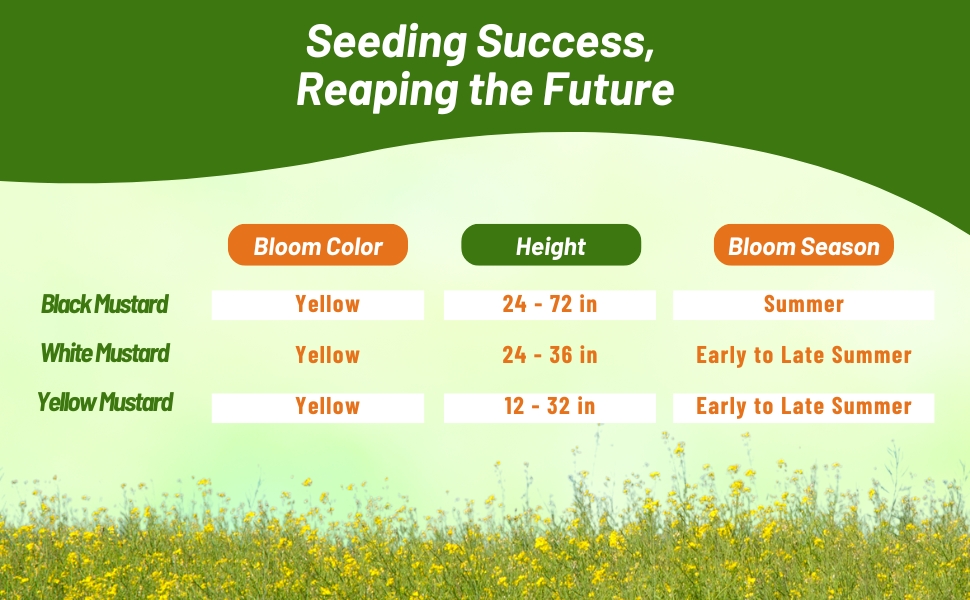
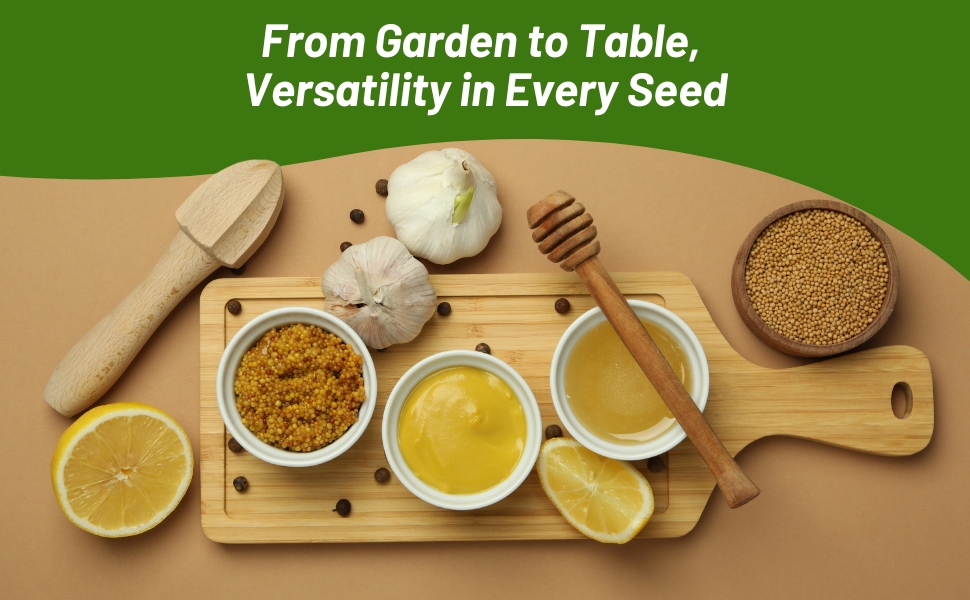
White Mustard (Sinapis Alba Nemagon) - This variety of white mustard is used for cover crops with outstanding nematode suppression. It hinders the life cycle of nematode larvae and acts as a natural biofumigant when turned in to the soil just before flowering. This high protein forage crop has high nitrogen content and increase soil tilth.
Nemagon white mustard seeds also contains high levels of glucosinate which is a compound similar to those found in commercial soil fumigants. It also features exceptional fast growth forming a compact covering to obstruct weeds.
The deep root system does a great job of re-utilizing nutrients that may have filtered past the root zone of crop plants. The tap root grows to a depth of three feet which helps break up soil and scavenge nutrients. Use Nemagon white mustard seed as a winter cover crop in home gardens, crop rotations and vineyards. It provides natural weed suppression, increased tilth, and increased organic soil matter. Nemagon is high in sulfer, which can become available to the subsequent crop when the mustard is incorporated in to the soil. Do not permit the mustard to go to seed or it could become a field impurity.
Seeding Rate: 10 - 12 lbs per acre
Planting Guide
TEMPERATURE
72F
AVERAGE GERM TIME
14 - 21 days
LIGHT REQUIRED
No
DEPTH
1/2 - 3/4 inch
SOWING RATE
10 - 12 lbs per acre
MOISTURE
Keep seeds moist until germination
Herb Specifications
SEASON
Annual
USDA ZONES
4 - 7
HEIGHT
24 - 36 inches
BLOOM SEASON
Early to late summer
BLOOM COLOR
Yellow
ENVIRONMENT
Full sun to partial shade
SOIL TYPE
Loam to heavy soils, pH 5 - 8
DEER RESISTANT
Yes
Common Questions
Which herbs can thrive in the kitchen?
Not all herbs are suitable for indoor growth. Herbs with woody, bushy growth, like rosemary are too large for indoor herb gardens. Consider other more suitable herbs for an indoor kitchen garden, such as chives, oregano, thyme, dill, mint, basil, cilantro, sage and savory. Each herb has specific growing needs, so ensure to provide the right amount of light, humidity, and air circulation. If using a single large container, ensure that all plants require similar amounts of sunlight and water. For instance, chives and cilantro may not need as much sunlight as dill and oregano.
What are good companion plants for herb gardens?
Pairing herbs based on watering requirements, like planting lavender with thyme or basil with chives, is ideal for maintaining the health of both plants. Avoid companion planting with catnip, lemon balm and mint as they should be grown in separate pots due to their rapid spreading nature that can overtake other plants in your indoor herb garden.
When do I establish an indoor herb garden?
Create a kitchen herb garden by propagating cuttings from your outdoor plants as the weather cools in the fall. If you opt to sow your indoor herb garden from purchased seeds, begin a few weeks before the anticipated first frost of the season. Most herbs can be harvested within a few weeks, so there is no need to plant too far in advance.
Do kitchen herbs need full sun?
Most herbs need 6 hours of sunlight a day to thrive. If you do not have this type of light available in your kitchen, consider a grow light that will run 14-16 hours per day 6 to 12 inches above your plants. NOTE: Rotate herbs periodically when grown in windows to let each part of the plant receive sunlight.
What time of year should you plant herbs?
Herbs grown in indoor gardens can be planted any time of year. Many gardeners prefer to grow their herbs outdoors during the summer growing season, and then move them to their indoor garden before the first frost of fall. If you prefer to start your seeds outdoors, you will need to wait until after danger of frost in the spring or start your seeds indoors 6 -8 weeks before last frost and transplant in your garden after danger of frost.
Do herbs come back every year?
Perennial herbs will come back each year when planted in the correct zone or grown indoors during the cold winter months. Popular perennial herbs are oregano, parsley, sage, fennel, chives, lavender, thyme and mint varieties.
How do I know when my herbs need watered?
Allow the soil to dry out just slightly before watering your herbs again. Give your indoor herb garden a dose of diluted water-soluble fertilizer every 2 weeks or so. Too much food will compromise the taste of the herbs. It is also beneficial to provide adequate humidity. If the indoor air is especially dry – which is often the case in regions with cold winters. Set the herbs pots on trays of stones. Fill the trays with water but keep the level below the drainage holes of your pots.
When do I water my outdoor herb garden?
Different herb plants will need different amounts of water so keep this in mind when planting your garden and keep similar plants together to simplify watering. Watering is best done in the early morning hours when temperatures are cooler. Many herbs are hardy. They can tolerate soil that is moderately dry. You want to keep an eye out for wilting when the soil is wet. Ideally, your herbs should make quick use of the water you give them. Saturated soil is not what you are after. Pay close attention to the coloration of the leaves on your herbs. Yellow leaves can be a sign of too much water, and so can black leaves. If you spot any mildew or fuzz on the herbs, too much moisture can be the problem.
How do I harvest my herbs?
Trim back flowering sections before they bloom for healthier leaves. Prune new growth on young plants weekly to encourage a fuller mature plant. Snip herbs for harvest when they are just a few inches tall. Pruning back the herbs often means a larger, longer harvest. Cut the new growth back at least one per week, even if you are not using the herbs in recipes (see drying and freezing page if you do not want to waste your harvest). Long stems that are about to set flower buds should be trimmed off as they appear.
What do I need to start an indoor herb garden?
Common tools needed for an indoor herb garden are: garden trowel, scissors for snipping, stones (optional). Materials for your herbs plants include seed, pots, potting soil, cactus potting soil (optional), pots or trays, fertilizer and a grow light if you do not have adequate sunlight of at least 6 hours per day for your plants.
How do I prepare my containers for planting?
Choose large, deep containers with drainage holes to accommodate fast-growing herbs. Fill the container with potting mix leaving about ½ inch clear at the top. Use standard commercial potting soil for most herbs but blend in cactus potting mix for herbs native to the Mediterranean, such as thyme and oregano which prefer dryer soils.
Can I put my indoor herb containers outside?
Yes! Move your potted herbs to the patio or deck when the weather warms in the spring and for a boost of sunshine.
How do I know when my herbs need larger containers?
When roots begin to emerge through the drainage holes of its container, it is time to repot the herbs. Replace the potting mix; the organic material in the potting mix breaks down over time. Remove any plants with woody or thickened stems and replace them with new seeds or seedlings.
Do herbs need fertilizer?
The short answer is yes. However, not all herbs have the same fertilizer needs. Herbs roughly fall into two groups. 1. Slow-growing herbs with small leaves or needles and fibrous, woody stems that are native to the mediterranean where they grow culinary lavender, month, marjoram, oregano, rosemary, sage, savory, tarragon and thyme. 2. Fast-growing herbs with larger, thinner leaves. These can be annuals such as basil, borage, cilantro, chervil and dill; bi-annual herbs such as parsley or perennials such as chives. Herbs in the first group generally need less fertilizer than herbs in the second group.
What type of nutrients do herbs need?
Start out by planting herbs in healthy soil rich in organic matter. In addition, they will benefit from an organic complete, slow-release fertilizer containing equal amounts of macronutrients nitrogen, phosphorus and potassium. A slow-release fertilizer is especially important if your garden has sandy soil because nutrients wash out quickly. To give fast-growing herbs that you harvest often an extra boost, you can also apply fish emulsion, an organic fertilizer that is high in nitrogen, with an NPK ratio of 4-1-1 or 5-1-1.
How often should I fertilize my herbs?
The frequency of fertilization follows the growth pattern of the herbs. In soil of average fertility, it is usually sufficient to apply a balanced fertilizer in the spring when they break dormancy, or when the new growing season starts. For other herbs, a light monthly application of a slow-release complete fertilizer should be enough – unless the leaves start to look yellow, which may be a sign of nitrogen deficiency. In that case, applying fish emulsion is a quick fix but before you reach for the fertilizer bottle, rule out that the yellowing of leaves is not caused by something else.
How do I fertilize my herbs in a container?
Herbs grown in containers need fertilizer applications more often, because with frequent watering that container plants require, the fertilizer in the potting mix washes out more quickly. Just as with sandy soil, it is important to use slow-release fertilizer. The roots of container plants are in a confined space, unlike herbs grown in the garden or raised beds, which can lead to over fertilization if you are not careful. Organic fertilizers are recommended over synthetic which often contain a high level of salts that can build up in the container over time. To prevent this, it is best to use half the strength of the fertilizer amount specified on the label for any type of fertilizer.
Is it possible to overfertilize herbs?
Adding too much fertilizer to herbs usually leads to an excess of nitrogen, which has undesirable results especially for slow-growing herbs. For basil and other thin-leaved herbs, the fast leaf growth induced by nitrogen is fine because you want your plants to be lush. For rosemary and other Mediterranean herbs however, rapid growth means that there is less concentration of essential oils causing the herbs to become less aromatic and have weaker flavor.
How do I prepare garden soil before planting an herb garden?
Once you have picked the location for growing your herb garden, you will need to prepare the soil. If the soil is sandy or clay heavy, add plenty of compost. Even if your soil is in pretty good condition, working some compost into the soil will help provide nutrients to the herbs while they are growing.
Can I harvest my herbs too often?
Many times, when a new gardener is starting an herb garden, they are afraid that harvesting the herbs frequently will hurt them. The opposite is true. Frequent harvesting of herbs will result in the herb plant producing more and more foliage, which increases the amount you are able to harvest. At the end of the season, you can dry or freeze your herb harvest to enjoy home grown herbs all year long.
I don’t have a good sunny spot outdoors for my herb garden, what can I do?
If your yard is mostly shaded, there is not much you can do to change that, but you can pick shade friendly herbs. Parsley, sweet woodruff and mint are good examples of herbs that don’t require as much light. If you are growing plants in low light, manage your expectations. Your herbs will grow but will be slow and results less impressive.
My container soil is staying wet, what do I do?
Choose a container that allow for water to drain. If you over water or if it rains too much a good pot will allow the water to flow to the bottom without soaking and rotting the roots of your plants. You can use rocks or pottery shards to fill the bottom of the container to help with drainage. This applies outdoors too. If your herbs constantly have wet feet, they won’t thrive. Either plan when planting your garden and add some sand for drainage or pick plants that don’t mind wet roots as much.
My herbs plants are going to seed, why?
The short answer is you are not pruning enough. To prevent rapid growth and encourage a bushy habit, be sure to prune your herb plants regularly. The more you pick off your stems and leaves the longer your herb plant will remain in its production cycle. If you start to see flower heads, snip them right away. When you fail to cut back the plant, it is likely to go to seed and complete its lifecycle. Once that happens, many plants die back. Keep cutting and pinching back flowers to prevent this from happening.
Should I throw away my seeds on their expiration date?
Seeds do not have an expiration date, rather they are a sell by date just like food. The dates on seed packages are guidelines to help you know when your seeds are getting old, but it does not mean you need to toss them. Every plant is different. Some seeds last longer than others. Most seeds, if kept cool and dry, will last 2 – 3 years. If you are unsure test them out by growing microgreens.
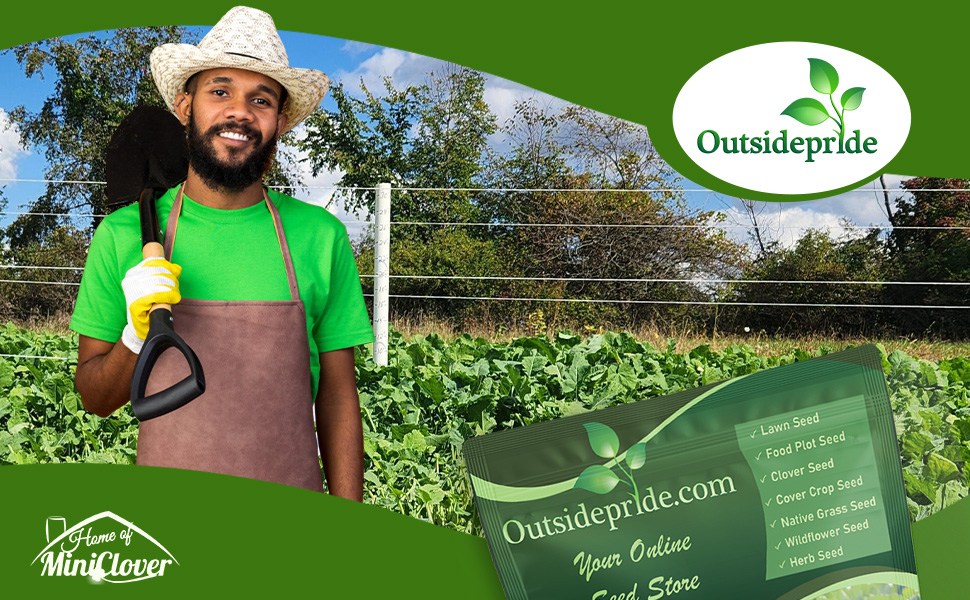

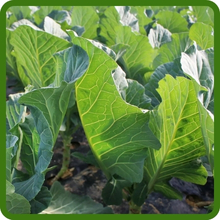
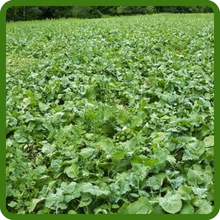


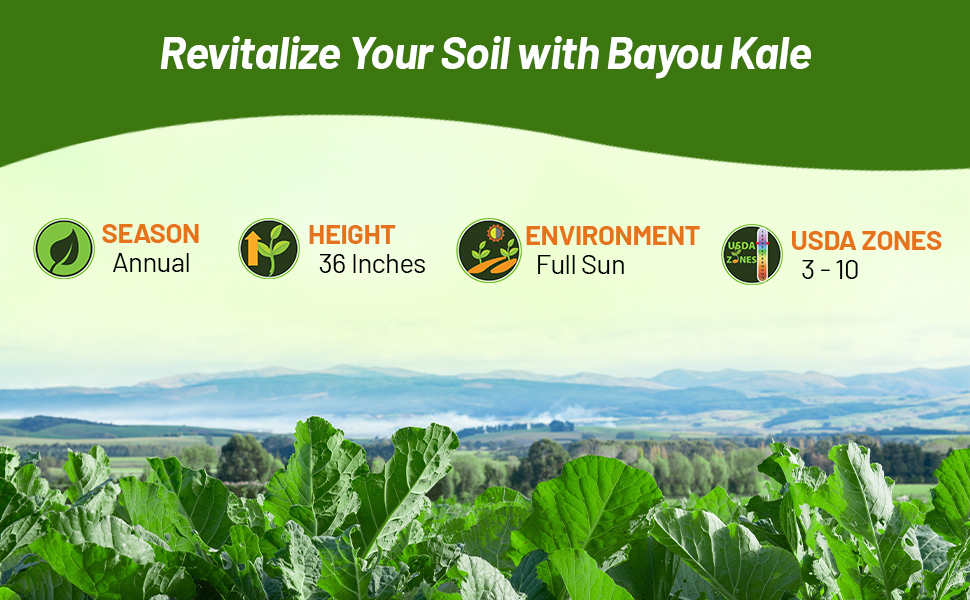
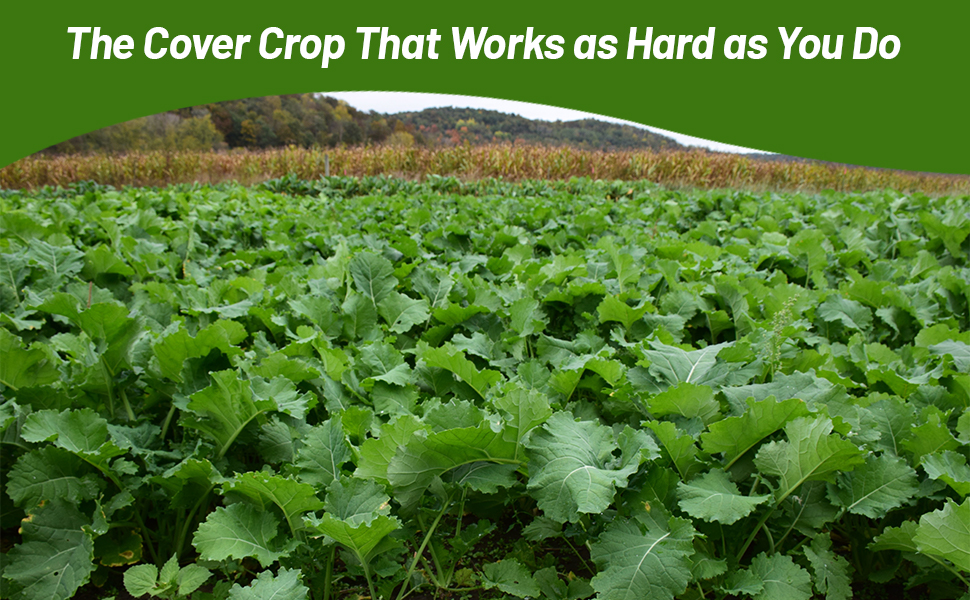
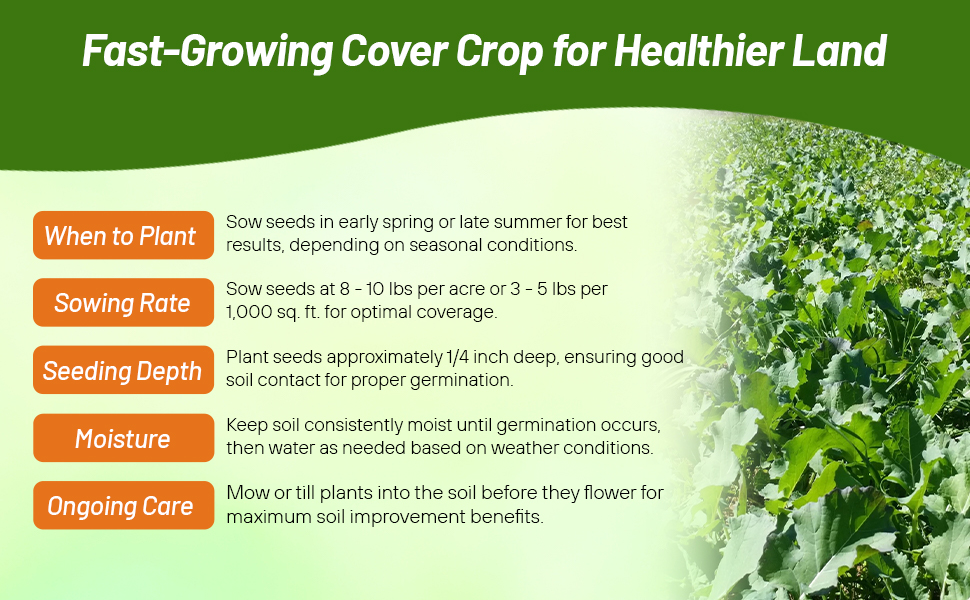
Bayou Kale (Brassica oleracea) - is a winter hardy member of the Brassica family that is highly digestible. It is known for its large, palatable leaves. and can provide up to 25% protein. High digestible forage for deer that is ideal for extended grazing in wildlife food plots providing quality winter forage. Kale has the highest cold tolerance of all the Brassicas, good winter hardiness and a high leaf to stem ratio. It may be grown both as a spring and early fall crop for winter grazing. Kale grows best in cooler weather with cold days and nights which will sweeten the leaves especially if subjected to a fall frost. Remember that Kale grows large leaves and may over shade other plants in your food plot. Kale prefers a pH of 5.5 to 7.0.
Bayou kale is a mid-maturing forage brassica with a smooth leaf, and a nutty flavor that is sweet to human taste. This kale variety has a smaller stem but can grow up to 3 feet tall. Bayou has excellent regrowth when rotationally grazed, and the stems are more palatable than forage rapes for cattle and sheep. Used in food plots for deer as well as upland game birds, animals will eat the Bayou first when planted beside other food plots.
When planted in late summer or early fall, it is considerably more winter-hardy than radishes and helps control erosion. The spring green-up of Bayou kale is similar to forage rapes, while its seed size and crop management are similar to other brassicas, like turnips. Seed should be planted at 6 - 10 lbs/ac when planted as a single specie and 2 - 3 lbs/ac when mixed with other crops. Recommended planting time for Northern Regions is summer when night time temperatures are consistently below 65 degrees. Planting should occur July - September for the Midwest and September - October for the South.
Forage Kale has show to help in opening up the soil because of its tap roots. As a cover crop kale can be planted in late summer or early fall; using it as a winter crop helps protect the soil longer from erosion.
Product Specifications:
- Excellent regrowth
- Forage brassica
- Good winter hardiness
- Great for food deer food plots
- Protects soil from erosion
- Use for: pasture, food plot, cattle forage, livestock grazing, cover crop
Planting Guide
SOWING TEMPERATURE
45F+
SEEDING RATE
6 - 10 lbs per acre
AVERAGE GERMINATION TIME
3 - 14 days
PLANTING DEPTH
1/4 inch
SOWING METHOD
Broadcast or drill
ENVIRONMENT
Full sun
USDA ZONES
3 - 10
ESTABLISHMENT RATE
Fast
Specifications:
LATIN NAME
Brassica oleracea
SEASON
Annual
WHEN TO PLANT
5 - 7 weeks before frost in fall
PLANT CHARACTERISTICS
Excellent regrowth, winter hardiness, erosion control
MOISTURE REQUIREMENTS
Moderate
CROP HEIGHT
36 inches
COLD TOLERANCE
Excellent
HEAT TOLERANCE
Fair
SHADE TOLERANCE
Good
DAYS TO MATURITY
55 - 75 days
IDEAL FOR
Erosion control, wildlife food plots, grazing, cover crop
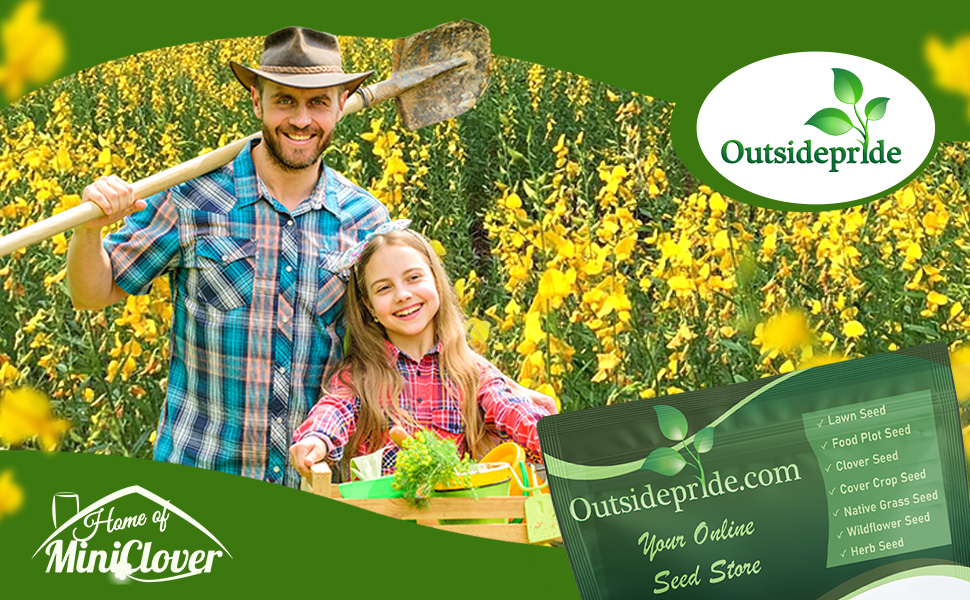
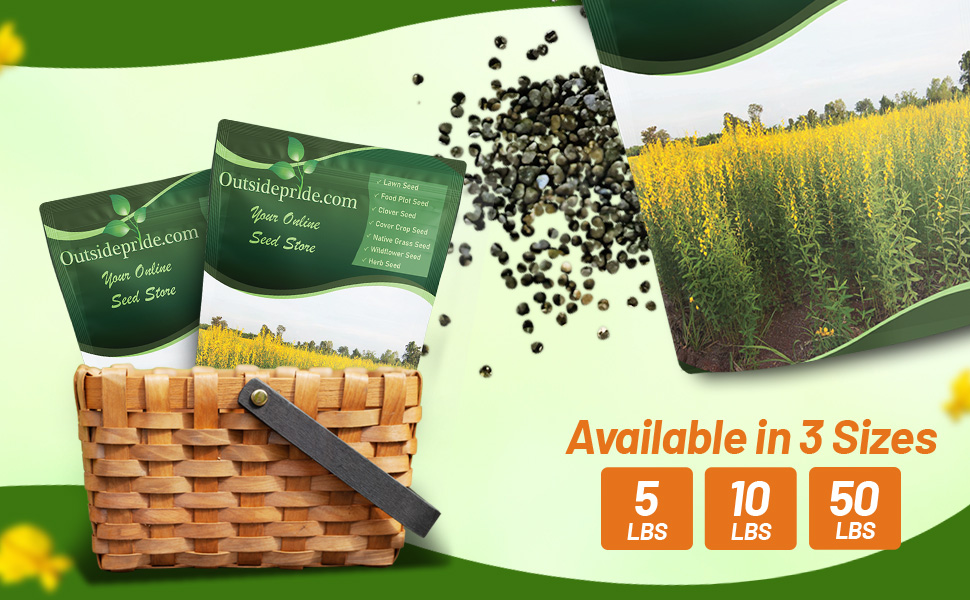
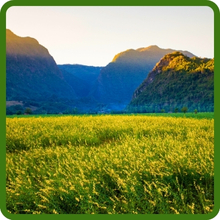
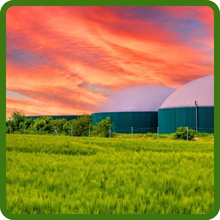
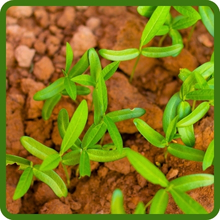
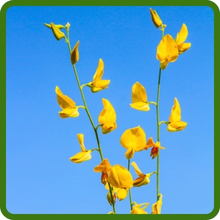
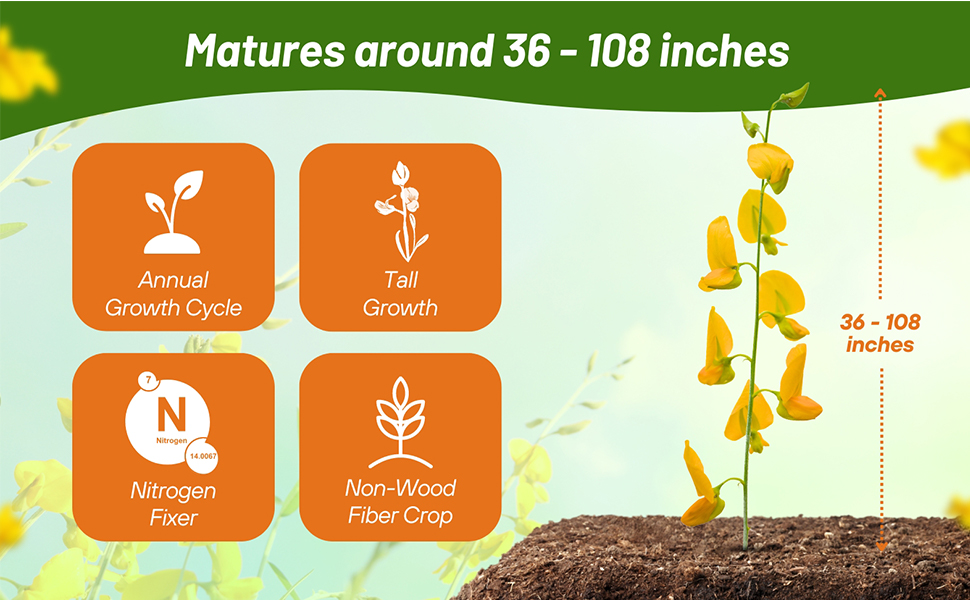
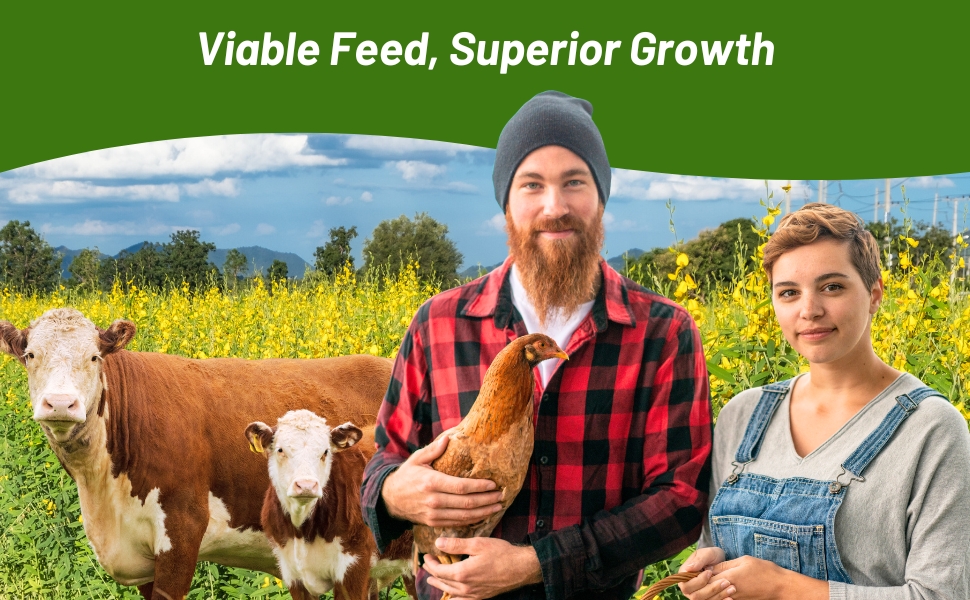
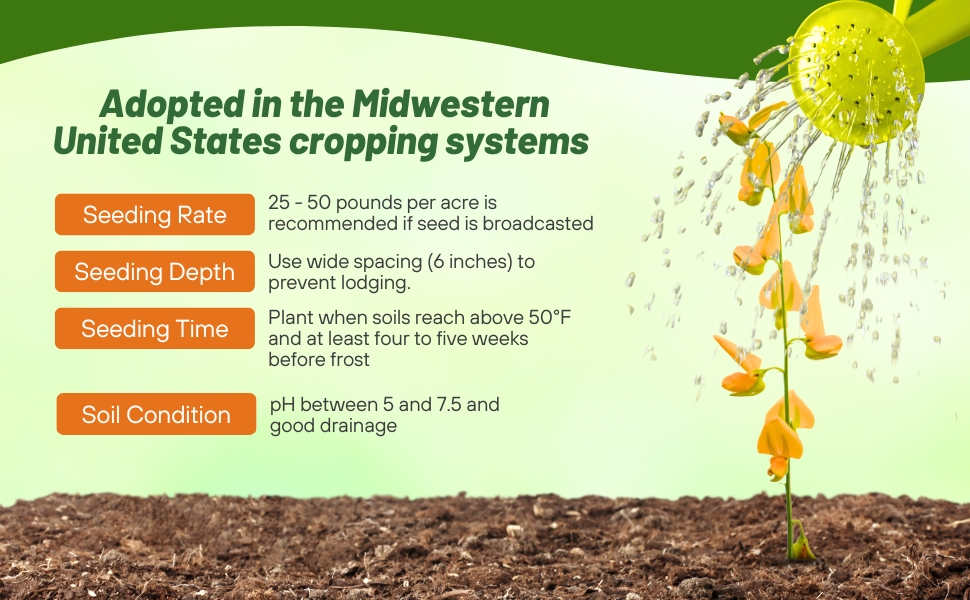
Sunn hemp (Crotalaria juncea L.) - is a legume commonly used as a cover crop for southern and sub-tropical and tropical farming systems. It has recently been more adopted in the Midwestern United States cropping systems. Sunn hemp has high rates of biomass production — over 20 percent greater than crimson clover and hairy vetch in research trials. In as little as 60 to 90 days it can produce 120 pounds of nitrogen per acre and can suppress weeds up to 90 percent.
Sunn Hemp is adapted to a wide variety of soil and environmental conditions, thriving through hot, dry summers and continuing to grow until the first frost. But sunn hemp isn’t just a soil builder — it also offers benefits as a forage producer. Sunn hemp is easy to grow and amazingly productive.
Because plants can reach 3 to 9 feet in height, wide spacing between rows (6 inches is recommended) may make plants susceptible to lodging. With adequate moisture, temperature and fertility, researchers have recorded a growth rate of 1 foot per week. Plants can return to or exceed this growth rate if slowed by temporary drought.
Planting Guide
SOWING TEMPERATURE
65F+
SEEDING RATE
25 - 50 lbs per acre
AVERAGE GERMINATION TIME
3 - 7 days
PLANTING DEPTH
1/4 - 1 inch
SOWING METHOD
Broadcast or drill
ENVIRONMENT
Full sun
USDA ZONES
8 - 11
ESTABLISHMENT RATE
Fast
Specifications:
LATIN NAME
Crotalaria juncea L.
SEASON
Annual
WHEN TO PLANT
Spring to early summer
PLANT CHARACTERISTICS
High biomass, nitrogen fixator
MOISTURE REQUIREMENTS
Moderate
CROP HEIGHT
36 - 108 inches
COLD TOLERANCE
Poor
HEAT TOLERANCE
Excellent
SHADE TOLERANCE
Poor
DAYS TO MATURITY
60 - 90 days
IDEAL FOR
Cover crop, soil improvement, green manure, forage, fiber production
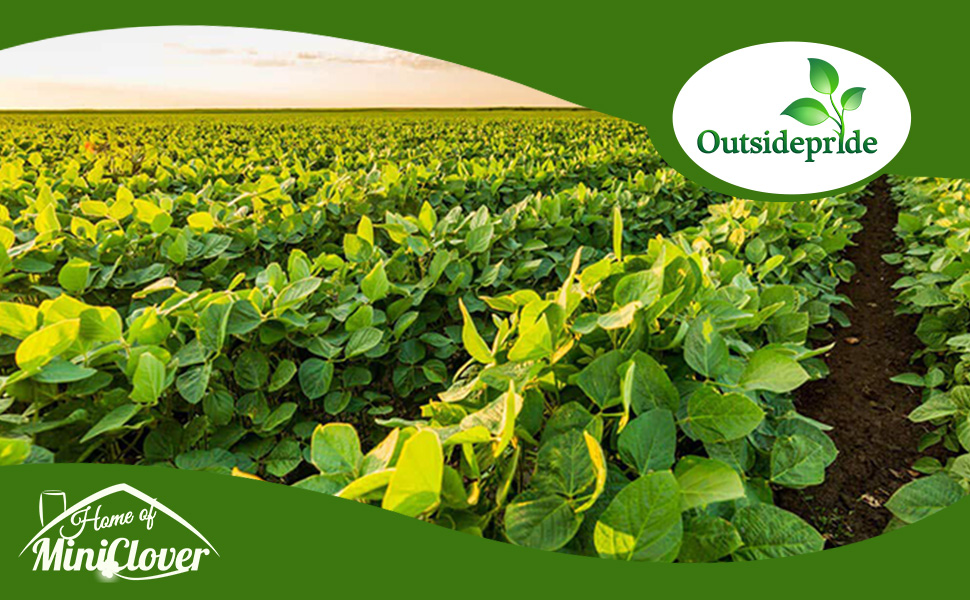
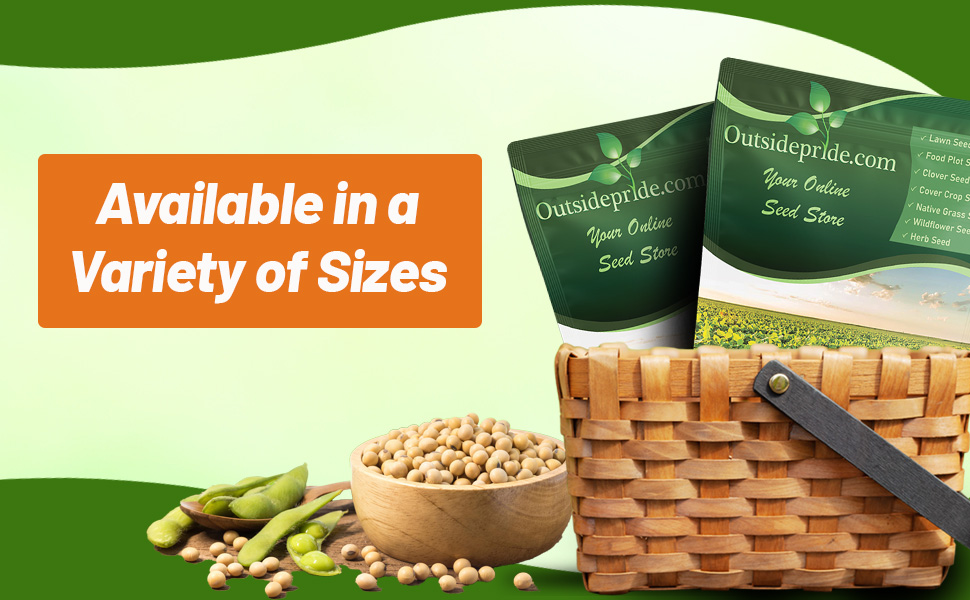
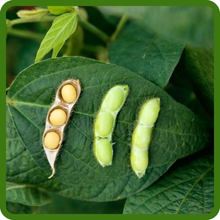
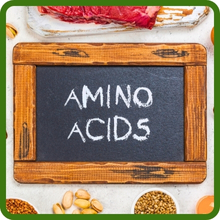
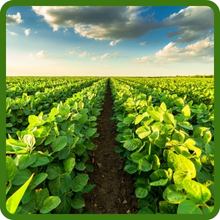
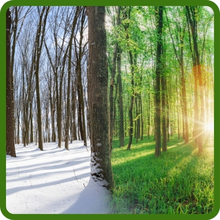
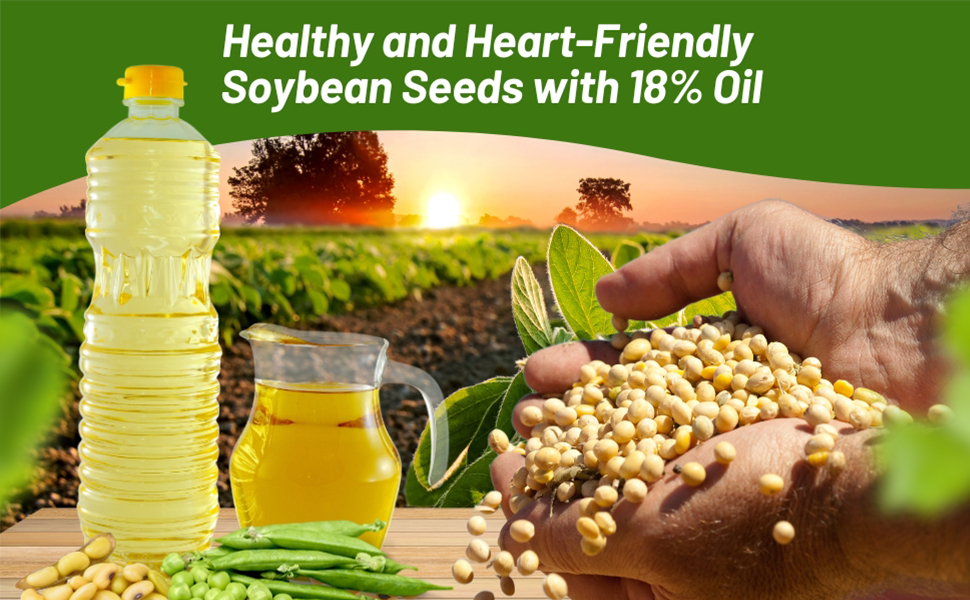
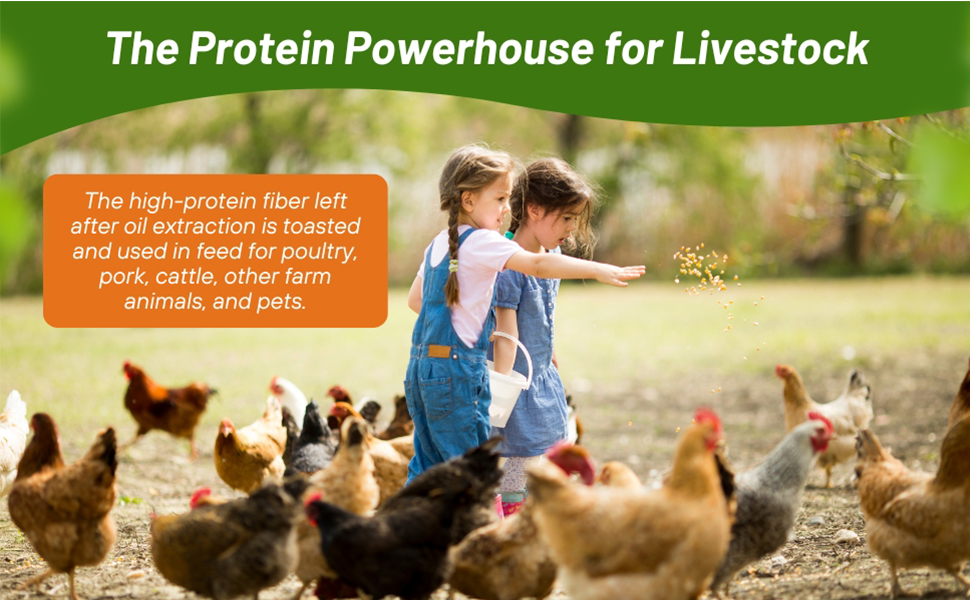
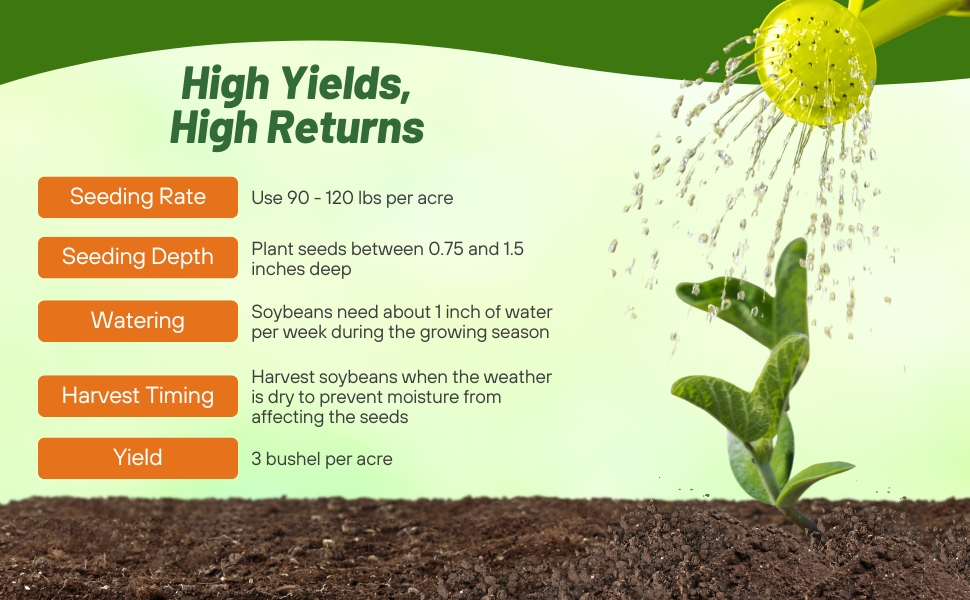
Soybeans (KS 5120N) - An heirloom variety which features good resistance to soybeans cyst nematode and soybean mosaic virus. It is an annual legume of the pea family which has edible seeds. The soybean is economically the most important bean in the world, providing vegetable protein for millions of people and ingredients for hundreds of chemical products.
When the farmer sells soybeans to a grain dealer, the beans may then go to a number of ultimate destinations. When processed, a 60-pound bushel will yield about 11 pounds of crude soybean oil and 47 pounds of soybean meal. Soybeans are about 18% oil and 38% protein. Because soybeans are high in protein, they are a major ingredient in livestock feed. Soybeans are processed for their oil and meal. A smaller percentage is processed for human consumption and made into products including soy milk, soy flour, soy protein, tofu and many retail food products. Soybeans are also used in many non-food industrial products.
Soybean processors bake the high-protein fiber that is left after the oil is removed and sell it for animal feed. Soybean oil is used in cooking and frying foods. Margarine is a product made from soybean oil. Salad dressings and mayonnaises are made with soybean oil. Some foods are packed in soybean oil such as: tuna and sardines. Baked breads, crackers, cakes, cookies and pies usually have soybean oil in them.
The high-protein fiber which remains after processing has removed the oil is toasted and prepared into animal feed for poultry, pork, cattle, other farm animals and pets. The poultry and swine industries are major consumers of soybean meal. Over half of the soybeans processed for livestock feed are fed to poultry, about one-quarter is fed to swine, and the rest is used for beef cattle, dairy cattle and pet food.
Planting Guide
SOWING TEMPERATURE
55F - 77F
SEEDING RATE
90 - 120 lbs per acre
AVERAGE GERMINATION TIME
5 - 10 days
PLANTING DEPTH
3/4 - 1 1/2 inches
SOWING METHOD
Broadcast or drill
ENVIRONMENT
Full sun
USDA ZONES
2 - 10
ESTABLISHMENT RATE
Fast
Specifications:
LATIN NAME
Glycine max
SEASON
Annual
WHEN TO PLANT
Spring to early summer
PLANT CHARACTERISTICS
Nitrogen fixator, easy establishment, high yields, oil
MOISTURE REQUIREMENTS
High
CROP HEIGHT
20 - 50 inches
COLD TOLERANCE
Poor
HEAT TOLERANCE
Good
SHADE TOLERANCE
Poor
DAYS TO MATURITY
80 - 120 days
IDEAL FOR
Livestock, cover crop, animal feed,
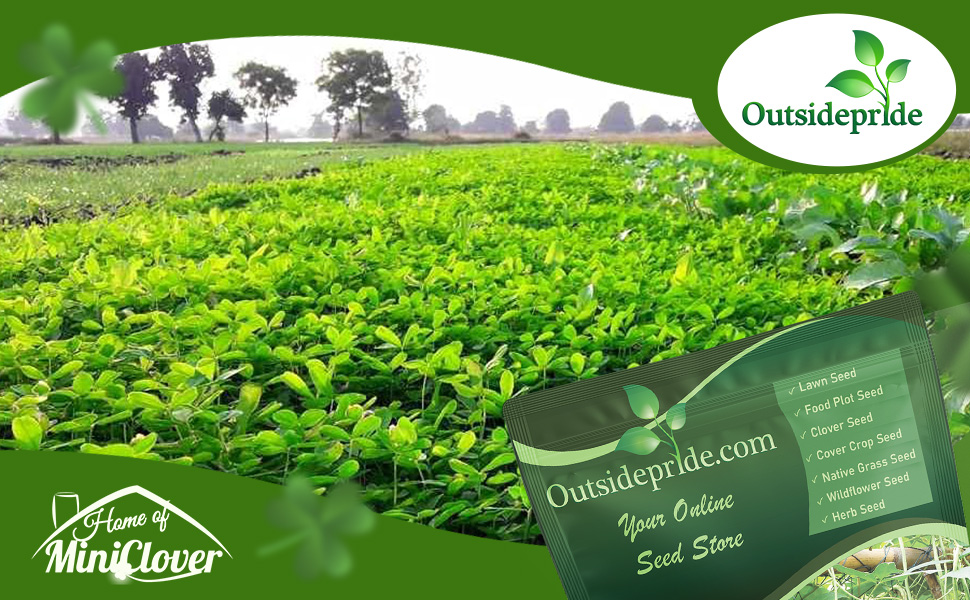
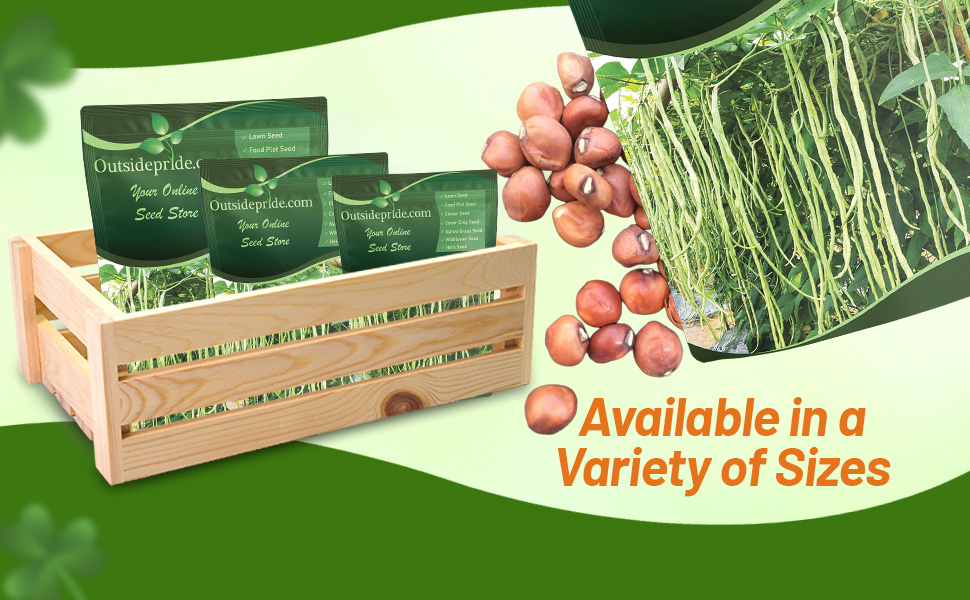
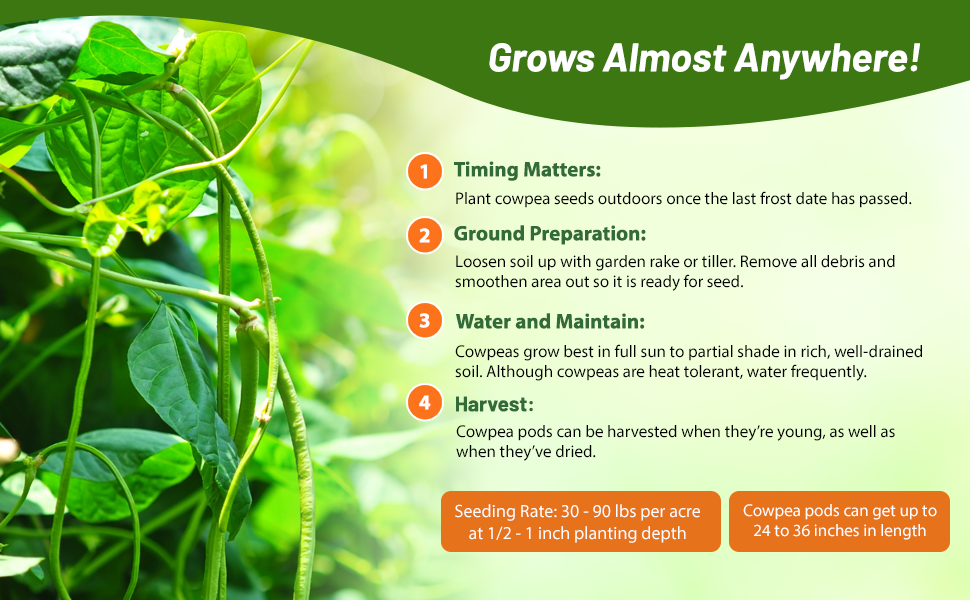
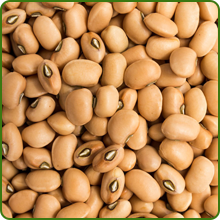
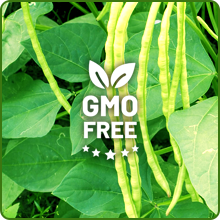
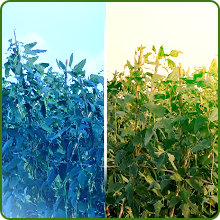

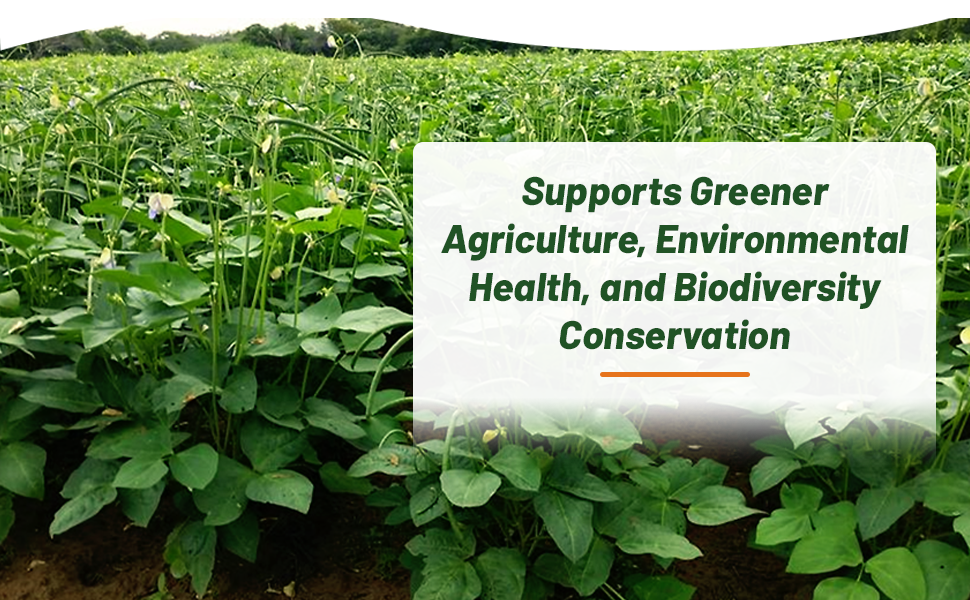

Cowpeas (Vigna Unguiculata) - Cowpeas grow 24 - 36 inches tall and are very heat and drought tolerant. They are very hardy, making them an excellent choice for food plots in the southern United States. Deer, pheasant, turkey, quail and other wildlife eagerly seek out the foliage and grain produced by cowpeas as they grow to maturity. Other animals such as: cattle, hogs, poultry, goats and other upland game birds will also enjoy feeding on cowpeas.
Cowpeas are the most heat loving legume found in the United States. They thrive in hot, moist climates, but are also very drought tolerant. Adapted to a wide range of soil types. Commonly used by farmers for silage and as a cover crop, but also widely planted as a high protein forage. Cowpeas are adapted to a wide range of soils, but prefers well drained soils with a pH between 6.0 - 7.0. Like all cowpeas, they can be consumed by humans in the form of snap beans and dry beans.
Cowpeas are perennial in USDA Zones 7 - 10, but are often grown in the midwest as an annual in USDA Zone 5 and 6.
Seeding Rate: 30 - 90 lbs per acre
Planting Depth: 1/2 - 1 inch deep
Planting Guide
SOWING TEMPERATURE
70F - 95F
SEEDING RATE
30 - 90 lbs per acre
AVERAGE GERMINATION TIME
7 - 10 days
PLANTING DEPTH
1/2 - 1 inch
SOWING METHOD
Broadcast or drill
ENVIRONMENT
Full sun to partial shade
USDA ZONES
5 - 10
ESTABLISHMENT RATE
Fast
Specifications:
LATIN NAME
Vigna unguiculata
SEASON
Annual
WHEN TO PLANT
After danger of frost
IDEAL FOR
Erosion control, nitrogen fixation, food plots
PLANT CHARACTERISTICS
Fast growing, high protein
MOISTURE REQUIREMENTS
Moderate - high
CROP HEIGHT
24 - 36 inches
COLD TOLERANCE
Poor
HEAT TOLERANCE
Excellent
SHADE TOLERANCE
Moderate
DAYS TO MATURITY
80 - 90 days
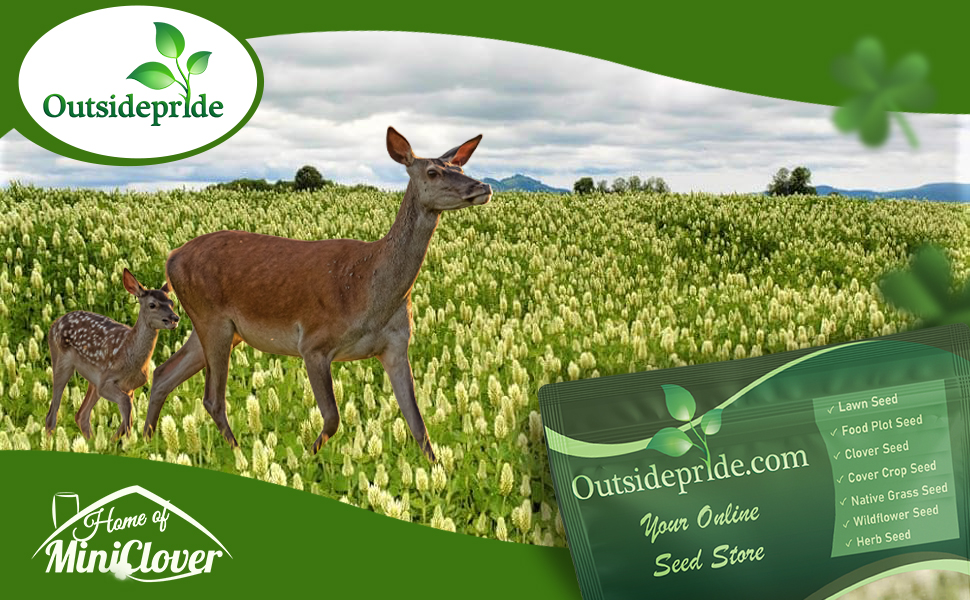
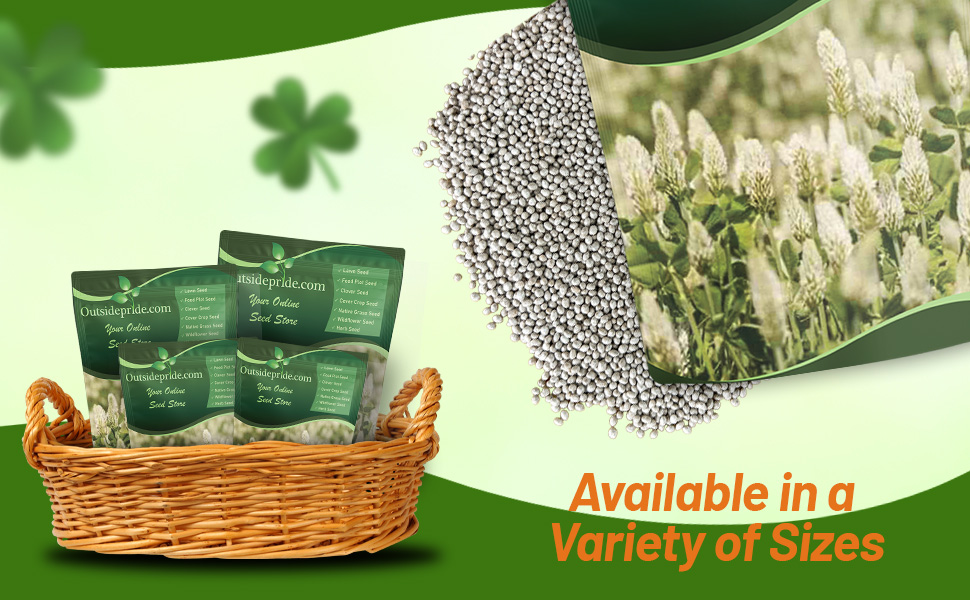
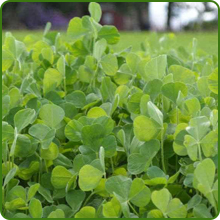
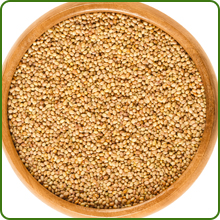
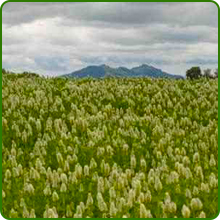
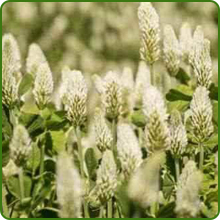
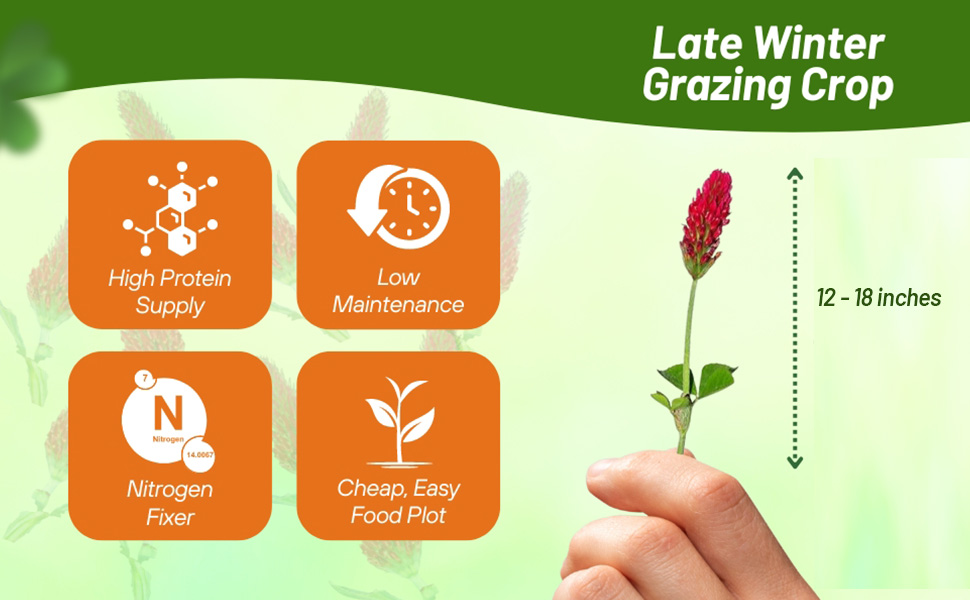
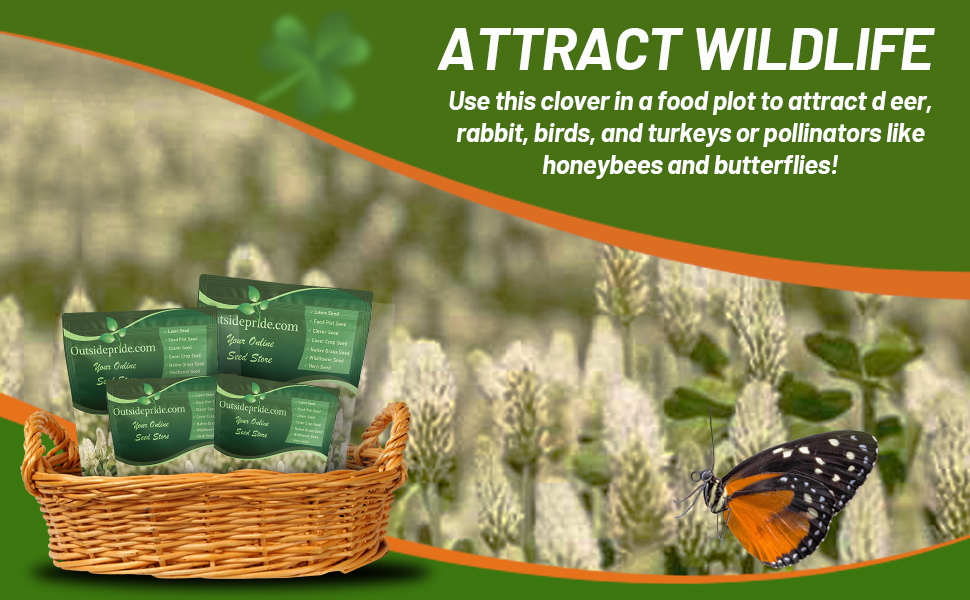
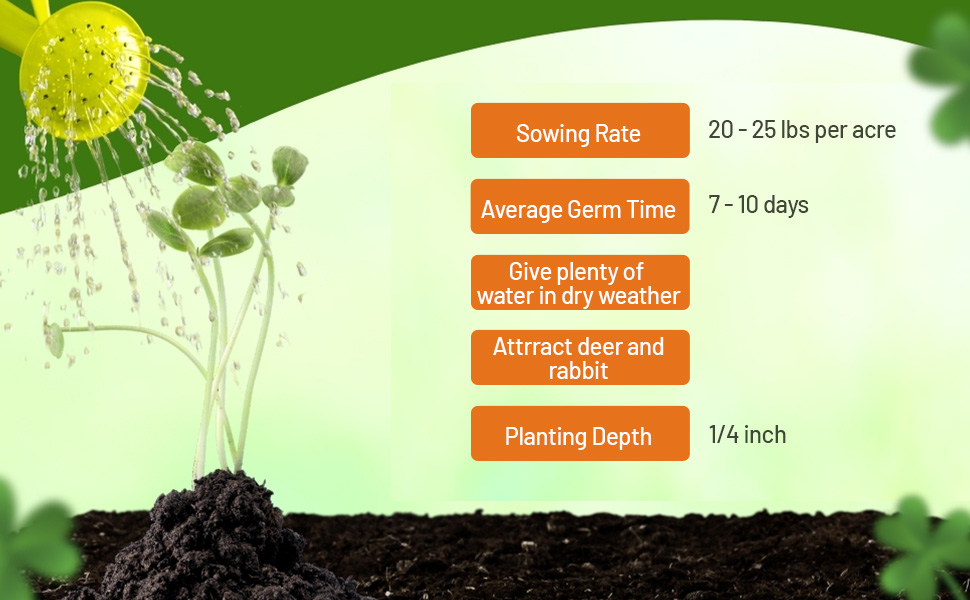
White Cloud Crimson Clover (Trifolium Incarnatum) - White Cloud crimson clover is the only white flowered Trifolium incarnatum cultivar in the US. White Cloud is truly white with white seeds. With a lack of red coloration, there are lower levels of bitter anthocyanins thus making it a sweeter clover so palatability and intake should be higher. Though not statistically quantified, anecdotal evidence have shown that White Cloud is preferred by livestock and wildlife over other palatable forage.
Use this unique crimson clover for hay, pasture, silage, livestock, forage, wildlife food plots, cover crops, green manure crops, crop rotations, nitrogen fixator, and for a ground cover. White Cloud is adapted to any region where crimson clover is used for cover crops, whether spring or fall sown. Its high dry matter yield and the ability of annual clovers to fix nitrogen makes White Cloud a great choice for cover crop or rotation/green manure applications.
Seeding Rate: 20 - 25 lbs per acre for broadcast seeding
Inoculated Seed - We now offer White Cloud crimson clover seed that has been coated with an inoculant for better establishment. Rhizobium strains are specifically chosen for each seed type. A key to any successful establishment and early seed development is moisture. This coating with inoculant is naturally water absorbent and helps attract soil moisture to the seed, getting your stand established quickly. This coating process which Outsidepride utilizes, assures that only the top-performing and crop-specific rhizobia will be applied to ensure your clovers reach maximum nodulation, stand establishment, and yield potential. The weight of the clover seeds will contain approximately 50% coating material that contains the inoculant and water holding material for better establishment and viability of the seed. There is no difference in the seeding rates between the coated and raw seed due to the increased germination and viability of the bulk clover seeds that are coated and inoculated.
Planting Guide
SOWING TEMPERATURE
50F+
SEEDING RATE
20 - 30 lbs per acre
AVERAGE GERM TIME
7 - 14 days
PLANTING DEPTH
1/4 - 1/2 inch
SOWING METHOD
Broadcast or drill
ENVIRONMENT
Full sun
USDA ZONES
3 - 9
ESTABLISHMENT RATE
Fast
WHEN TO PLANT
Spring to late summer
Clover Specifications
LATIN NAME
Trifolium incarnatum
SEASON
Annual
HEIGHT
12 - 18 inches
BLOOM COLOR
White
IDEAL FOR
Grazing, hay, wildlife, orchards, cover crop, pollinator, compaction control
PLANT CHARACTERISTICS
Easy to establish, weed supression
MOISTURE REQUIREMENTS
Moderate
ACIDIC SOIL TOLERANCE
Moderate
COLD TOLERANCE
Good
HEAT TOLERANCE
Good
SHADE TOLERANCE
Good
FERTILITY NEEDS
Low
MATURE HEIGHT
12 - 18 inches
















